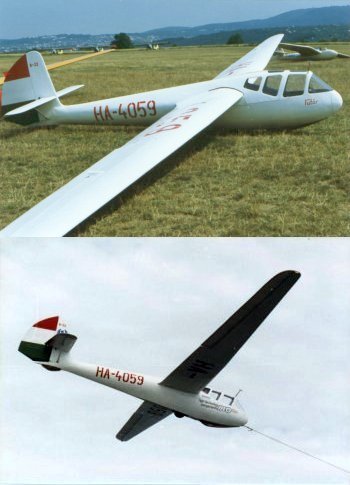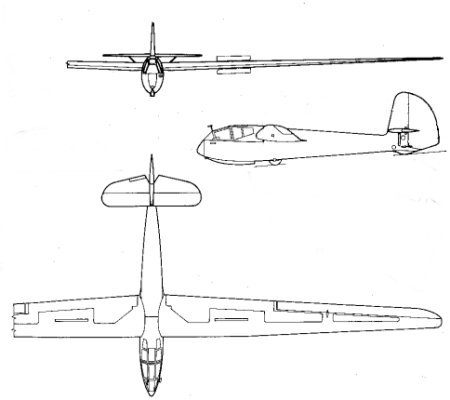HUNGARIAN
GLIDERS
1933-2000
| Type designation: |
R-22 |
| Name: |
Futár |
| Designer: |
Ernő RUBIK |
| Class: |
High performance |
| General arrangement: |
Cantilever, shulder wing, closed cockpit, fixed wheel, traditional tail unit |
| Crew: |
1 |
| First flight: |
Winter of 1943 |
| Manufacturer: |
Aero Ever Ltd., Esztergom |
| Number of built: |
11 |

.jpg)
Short history:
At the beginning of the 1940s Ernő Rubik started to design a new high performance glider. His aim was to create a glider with better performance than that of the Olympia-Meise and the M-22, the high performance glider types that were used at that time in Hungary.
The R-22 Futár was a shoulder wing, single seat high performance glider. It was licensed to be launched by bungee-cord, winch and aero-towing. The type was certified for basic aerobatic figures as well as cloud-flying. The prototype first flew in the winter of 1943. The type certificate had been issued in the spring of 1944, however the serial production did not started in 1944 because of the war. The prototype crashed at an airshow in the summer of 1944, when her pilot had got a heat stroke and fainted. The slightly damaged glider had been repaired after the war and flew in May 1st of 1947. Between 1948 and 1950 another 10 R-22 were built.
Structure: All wooden
Wing:
The cantilever wing had one main spar. The wing in front of the spar was built as a plywood covered torsion resistant box. The constant chord ailerons run from mid-wing to wingtip. In the line of the leading edges of the ailerons secondary spars run along the whole span. Behind the torsion box the wind was covered by fabric. Working on both surfaces of the wings Göppingen type airbrakes were fitted. The half-wings were connected directly to each-other by one main pin and by two smaller pins to a steel-tube frame built into the fuselage. The secondary spars were connected to the fuselage by pins as well. The wing connection made it possible to fold the wings alongside the fuselage after taking out the main pin connecting the two half-wings.
Fuselage:
The fuselage was a plywood covered semi-monocoque construction braced with frames and longerons. Under the front part of the fuselage a twin keel were fitted. The fixed brakeable wheel positioned in front of the c.g. was flanked by the keels. The landing gear consisted of the wheel and a front skid as well as a small skid under the vertical stabilizer. Both skids were rubber dumped. The vertical stabilizer was integrated structurally to the fuselage and was covered by plywood. The canopy had been constructed of flat plexiglass pieces and it was removable.
Tail unit:
The tail unit had a traditional arrangement. The horizontal stabilizer was strutted. Removing the lower connecting pins the horizontal stabilizer together with the elevators could be folded up to the vertical surfaces. All control surfaces were fabric covered.
.jpg)


.jpg)
.jpg)
